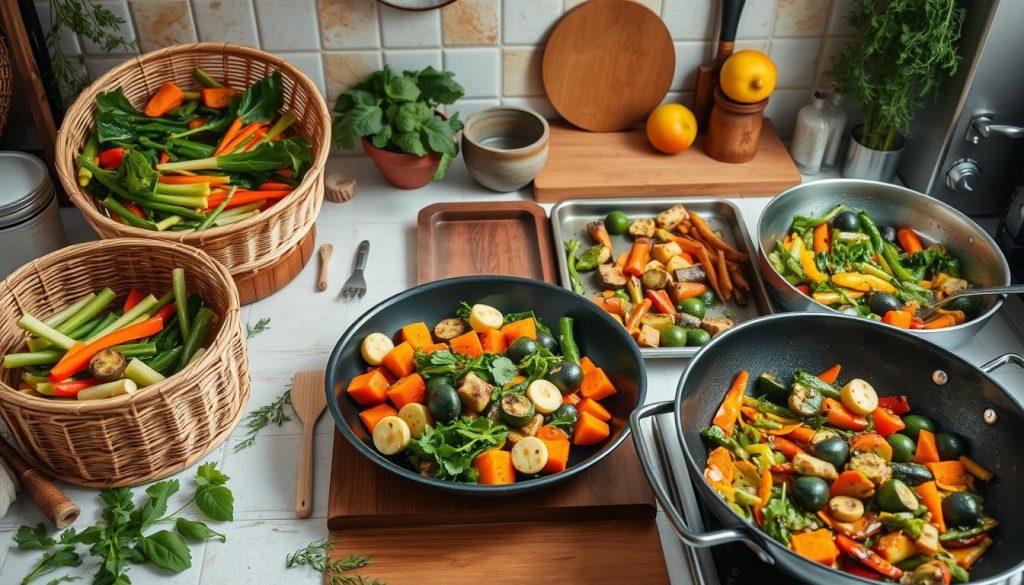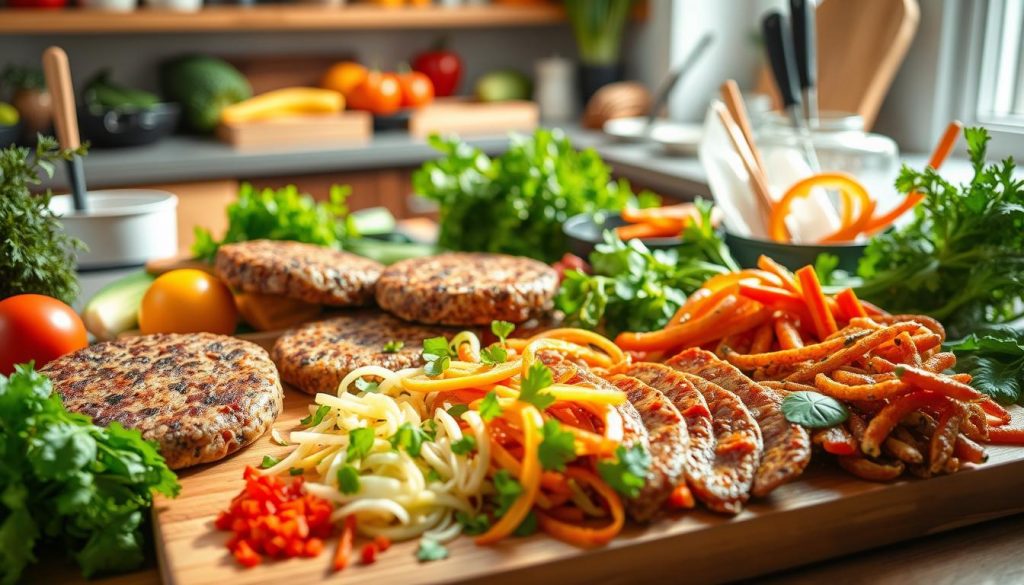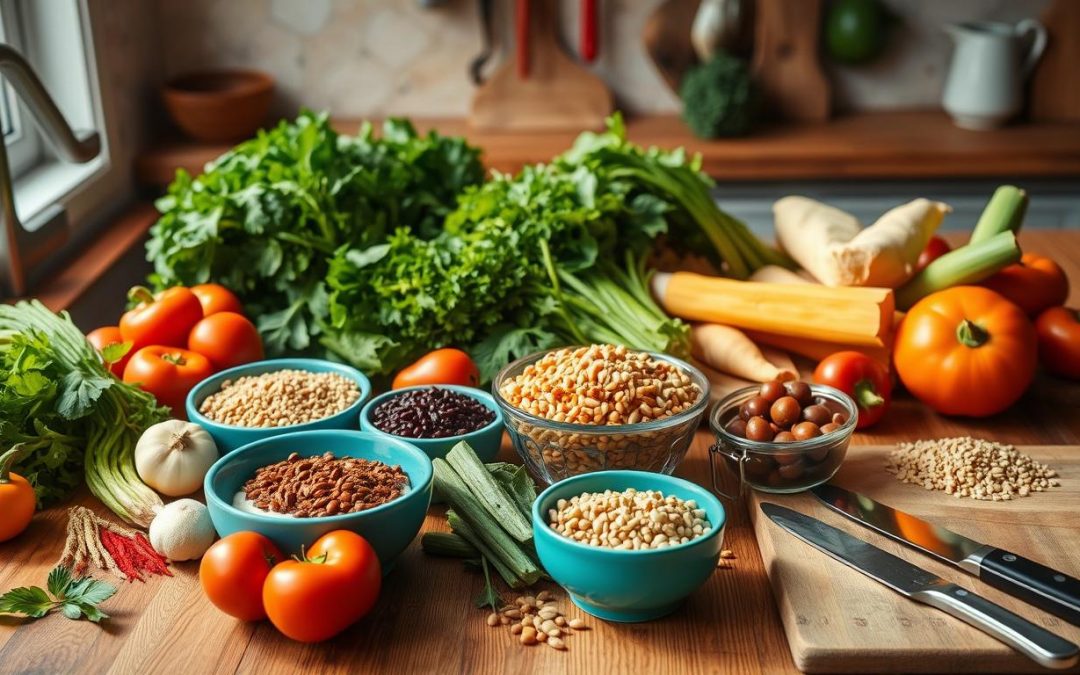More adults are trying plant-based diets, with a big increase in interest1. Around 39% of U.S. adults are now eating more plant-based meals1. We’ll share key tips for making tasty and healthy vegetarian dishes at home.
The “Meatless Monday” movement is gaining traction, with about 20% of American homes joining in1. Online searches for vegan recipes have jumped by over 100% in five years1. We’ll explore how to add flavor without meat, different cooking methods for veggies, and meat alternatives.
Table of Contents
Key Takeaways
- Understanding the basics of vegetarian cooking is essential for creating delicious and healthy meals
- Exploring different cooking methods, such as roasting and sautéing, can enhance flavor and texture2
- Incorporating plant-based protein sources, like beans and tofu, can add variety to your meals2
- Meal prepping can save time and reduce food costs by 25-30%1
- Learning about various types of grains, such as quinoa and farro, can increase fiber and nutrient intake2
- Utilizing frozen vegetables can decrease meal prep time by 20-30%2
Understanding the Basics of Vegetarian Cooking
Vegetarian cooking is all about the basics. A good vegetarian diet can meet the nutritional needs of everyone, even pregnant or breastfeeding women3. You can make tasty and healthy meals using various cooking techniques and ingredients. A guide to vegetarian ingredients is a great place to start planning your meals.
Protein sources in vegetarian diets include tofu, tempeh, and legumes. You’ll also need whole grains like quinoa and brown rice, and spices and herbs. Techniques like roasting and grilling enhance flavors. Try making stir-fries and curries with different vegetables and legumes.
Here are some daily recommended amounts for a 2,000-calorie vegetarian diet:
- Vegetables: 2 1/2 cups
- Fruits: 2 cups
- Grains (mostly whole): 6 1/2 ounces
- Dairy: 3 cups
- Proteins: 3 1/2 ounces
- Oils: 27 grams
Make sure to eat a variety of foods to get all the nutrients you need4.
Embracing Seasonal Vegetables
Exploring easy vegetarian meals means looking at seasonal produce5. Seasonal veggies are fresher, more nutritious, and help local farmers5. They also support local economies5. Adding them to our meals helps us eat a variety of fruits and veggies all year5.
Vegetarian meal planning gets better when we think about the season6. Autumn is perfect for carrots and beetroots, full of antioxidants and fiber6. Seasonal cooking cuts down on waste and supports local farmers6. It’s key for keeping farmland and biodiversity alive6.
Some top seasonal veggies are:
- Asparagus and leafy greens like spinach and kale in the spring6
- Squash, pumpkins, and root veggies in autumn7
- Cruciferous veggies like cabbage, broccoli, and cauliflower in winter6
Using these seasonal veggies in our meals makes them tasty and healthy5. It also helps local farmers and supports sustainability5.
Mastering Flavor without Meat
Exploring vegetarian cooking means learning to add flavor without meat. We can do this with herbs, spices, and umami-rich ingredients. Tara’s Tuesday Tips says loving spices is key for new vegetarians8. By using these, we can make tasty and fulfilling vegetarian meals.
Herbs and spices are key to mastering flavor. Herbs like basil and oregano brighten and deepen our dishes. Spices like cumin and paprika add warmth and complexity. Umami-rich ingredients like miso and soy sauce add depth and richness8. Trying different herbs and spices lets us create unique flavors.
For inspiration, check out cookingtipsandreviews.com on essential spices. We can also try roasting and grilling to enhance our ingredients’ natural flavors.
Techniques to Enhance Flavors
Techniques like marinating, braising, and reducing can make flavors richer. Marinating in herbs and spices adds depth and complexity8. Mastering these techniques makes our vegetarian meals flavorful and satisfying.
By following these tips, we can add flavor without meat and enjoy tasty vegetarian dishes. Whether using herbs, spices, or techniques, the key is to experiment and have fun8. With practice and patience, we can become skilled vegetarian cooks and enjoy a plant-based diet.
Cooking Methods for Vegetables
Choosing the right cooking method is key for easy vegetarian meals. The right techniques can enhance the flavors of our quick dishes. Steaming is great for keeping nutrients in green veggies, making it a top choice for vegetarian cooking9.
Popular cooking methods include steaming, roasting, and grilling. These methods help keep vegetables’ natural flavors and textures. For instance, roasting vegetables at high heat makes them sweet. Grilling adds a smoky taste to our quick vegetarian dishes9.
Here are some tips for cooking vegetables using different methods:
- Steaming: This method is great for preserving nutrients and can be used for a variety of vegetables, including broccoli and carrots9.
- Roasting: This method brings out the natural sweetness in vegetables and can be used for vegetables like Brussels sprouts and sweet potatoes10.
- Grilling: This method adds a smoky flavor to vegetables and can be used for vegetables like zucchini and bell peppers10.
By using these cooking methods, we can make a variety of easy vegetarian meals. These meals are not only tasty but also healthy. Whether it’s a quick dish or a more elaborate meal, the right cooking technique is essential9.

Recipe Ideas for Beginners
Starting with healthy vegetarian recipes is key. For beginners, easy vegetarian meals are plentiful. For example, one-pot enchilada pasta feeds 6 and takes 30 minutes to make11. Another beginner-friendly dish is the quinoa vegetable stew12.
Popular vegetarian meal planning ideas include quick weeknight meals. Vegetarian burgers, for instance, are ready in 20 minutes and serve 411. There are about 77 beginner-friendly vegetarian recipes, with prep times ranging from 25 to 30 minutes12.
Here are more beginner-friendly ideas:
- Vegetarian skillet lasagna, which serves 4 people and can be prepared in 25 minutes11
- Grilled chickpea salad sandwich, which serves 4 people and can be prepared in 30 minutes11
- Kimchi fried rice, which serves 4 people and can be prepared in 15 minutes11
These recipes are perfect for those new to meat-free options. They offer a variety of flavors and textures. With easy vegetarian meals and healthy vegetarian recipes, you can easily plan your vegetarian meals.
Nutritional Considerations
Exploring vegetarian cooking means looking at diet’s nutritional side. A well-planned vegetarian diet can give us all the nutrients we need for health. We can get this by using different vegetarian cooking techniques and plant-based cooking ideas in our meals. Knowing about vegan cooking’s nutrition is key for tasty and healthy dishes13.
A good vegetarian diet includes many foods from different groups. This includes whole grains, fruits, veggies, and legumes. Healthy recipes like vegetable upma, chana masala, and whole-grain pasta with veggies and tofu are great13. It’s also important to watch our intake of added sugars, saturated fats, and sodium. The American Heart Association says we should not have more than 2,300 milligrams of sodium a day14.
Here are some key nutrients to think about in a vegetarian diet:
- Iron: found in dark leafy greens, beans, and fortified cereals
- Vitamin B12: found in fortified plant milk, cereals, and meat substitutes
- Calcium: found in dairy products, fortified plant milk, and dark leafy greens
- Vitamin D: found in fortified foods, sunlight, and supplements
By adding these nutrients to our diet and using healthy vegetarian recipes, we can make sure our diet is balanced and nutritious. For more info on vegetarian nutrition, we can check out the Academy of Nutrition and Dietetics. They offer reliable nutrition advice and recommendations13.
| Nutrient | Food Sources |
|---|---|
| Iron | Dark leafy greens, beans, fortified cereals |
| Vitamin B12 | Fortified plant milk, cereals, meat substitutes |
| Calcium | Dairy products, fortified plant milk, dark leafy greens |
| Vitamin D | Fortified foods, sunlight, supplements |
Meal Prep for Busy Lives
Planning is key for easy vegetarian meals. According to Tara’s Tuesday Tips, meal prep is essential for busy lives15. Just 1 hour a week can save time, money, and reduce stress15. Quick dishes like overnight oats take only 5 minutes to prepare15.
Vegetarian meal planning gets easier with freezer-friendly options. These can last up to 3 months when stored right15. Meals like Meal Prep Buffalo Chicken Wraps are great for busy weeks or school lunches15. Using repurposed ingredients helps reduce food waste, making meal planning smarter15.
Meal prep offers many benefits. It can make you happier and save 2-3 hours a week16. It also cuts food waste by about 30%16. Creating 3-5 base dishes helps avoid meal fatigue and makes prep more efficient16. Eating a lunch prepared the night before can boost productivity by 20-40%16.
- Start with one meal and gradually scale up17
- Utilize seasonal shopping to increase efficiency and reduce costs17
- Use frozen fruits and vegetables, which are often cheaper and nutritionally comparable to fresh17
- Prepare homemade dips, dressings, and sauces ahead of time to enhance meal options throughout the week17
By following these tips, you can make vegetarian meal planning easy. Incorporate easy and quick vegetarian dishes into your routine.
| Meal Prep Tip | Benefit |
|---|---|
| Plan ahead | Reduces stress and saves time |
| Use freezer-friendly options | Convenient and reduces food waste |
| Repurpose ingredients | Reduces food waste and saves money |
Exploring Meat Alternatives
Exploring meat alternatives is an exciting journey in vegetarian cooking. The demand for plant-based options has led to many new products. Some meat substitutes are highly processed, lacking the nutritional benefits of other plant-based foods18.
Using plant-based meat substitutes can make dishes more flavorful and textured. Plant-based cooking ideas often involve creative uses, like in veggie burgers or sausages. For healthy vegetarian recipes, it’s key to pick substitutes low in sodium and saturated fats, but high in protein and fiber.
It’s important to know the nutritional value of meat alternatives. For example, a 4-ounce cooked beef burger has about 28 grams of protein18. A Beyond Burger, made from pea protein, has 20 grams of protein in a 4-ounce patty18. Foods like quinoa, lentils, and chickpeas are rich in nutrients, fiber, and protein18.
Popular Plant-Based Meat Substitutes
- Veggie burgers
- Meatless sausages
- Tofu
- Tempeh
How to Cook with Meat Alternatives
Cooking with meat alternatives needs creativity and experimentation. Always follow the package instructions for cooking times and temperatures. Marinating or seasoning can also improve their flavor and texture.

Pros and Cons of Plant-Based Meats
Plant-based meats have many benefits, like being better for the environment and lowering cholesterol. But, they can be high in sodium and preservatives19. Some vegan meat alternatives have sodium levels up to six times higher than traditional dishes. Yet, they require much less water and resources than animal meat18.
| Product | Calories | Protein | Fat |
|---|---|---|---|
| Traditional Beef Burger | 120-243 | 28g | 5.9-21.5g |
| Plant-Based Burger | 130-222 | 20g | 2.4-12g |
In conclusion, exploring meat alternatives can add variety and excitement to your vegetarian diet. By understanding the pros and cons of plant-based meats and using them in your vegetarian cooking techniques, you can make delicious and healthy vegetarian recipes for any occasion.
Creative Ways to Use Legumes
Legumes are a versatile and nutritious ingredient. They add protein, fiber, and flavor to vegetarian dishes. We can use them in stews, salads, and quick dishes. Cooking with legumes boosts protein and fiber in our vegetarian diet20.
When cooking with beans and lentils, remember a few techniques. Soaking dried beans overnight cuts down cooking time. This makes meal prep easier21. Dried beans cook in about 1-2 hours after soaking22. Canned beans are also convenient, with about 6-8 grams of protein per half-cup20.
Here are some easy legume-based salads and meals we can make:
- Refried Bean Tostadas: 588 calories per tostada, 31g fat, 19g protein20
- Bean Burgers: 323 calories per burger, 8g fat, 13g protein20
- Penne with Veggies and Black Beans: 300 calories per 1-1/3 cups, 7g fat, 14g protein20
Legumes are a great protein source for meals. They are also high in fiber, which can lower cholesterol. With these easy vegetarian meals, we can make delicious and nutritious dishes using legumes and various cooking techniques.
Incorporating Whole Grains
Exploring healthy vegetarian recipes means talking about whole grains. Grains like brown rice, quinoa, and barley are full of nutrients and fiber. They’re perfect for easy vegetarian meals23. Whole grains keep all parts of the grain, making them more nutritious than refined grains.
Whole grains are great for vegetarian meal planning. They can be used in salads, soups, and main dishes. For example, quinoa needs 2 cups of water for every 1 cup of quinoa and cooks in about 15 minutes23. Brown rice needs 2 cups of water for every 1 cup of rice and cooks in about 45 minutes23.
Other whole grains to try are bulgur, farro, and barley. Bulgur cooks with 2 cups of water for every 1 cup of bulgur, sitting off heat for 15 minutes after boiling23. Farro cooks with 3 cups of water for every 1 cup of farro and takes about 30 minutes to cook2324. Whole grains add nutrition and variety to meals, making them a key part of healthy vegetarian recipes.
Here are some tips for adding whole grains to your diet:
- Start by substituting refined grains with whole grains in your favorite recipes
- Experiment with different types of whole grains, such as quinoa, brown rice, and barley
- Try adding whole grains to your salads, soups, and main dishes for added texture and flavor
Adding whole grains to your diet makes for delicious and nutritious vegetarian meals. They’re perfect for those looking for healthy recipes or just want to mix things up2324.
Making Your Own Plant-Based Staples
Starting a vegetarian lifestyle can be very rewarding. But, it does take a bit more work in the kitchen. Making your own essential staples at home can make your meals better25. You can make everything from vegetable broth to creamy nut milks and tasty sauces. These homemade basics add great taste and nutrition to your dishes.
Let’s talk about vegetable broth. Making your own broth is cheaper and lets you choose what goes in it26. Just save vegetable scraps like onion peels and carrot tops in the freezer. Then, simmer them with water, herbs, and spices to make a rich broth. This broth is great for soups, stews, and sauces, adding flavor to your plant-based meals.
Now, let’s look at DIY nut milks. Store-bought milks can be pricey and have additives26. Making your own almond, cashew, or oat milk at home is healthier and cheaper. It’s easy to make and you can adjust the flavor to your taste.
Lastly, making your own sauces can make your vegetarian dishes taste better25. You can make everything from pesto to creamy dressings. These sauces add flavor and let you try new ingredients and techniques.
By making your own plant-based staples, you open up a world of possibilities in the kitchen26. You’ll save money and enjoy making healthy, tasty meals. Start making your own vegetarian essentials and explore new recipes and techniques. Your Guide to Vegan Cooking is a great resource to help you get started.
FAQ
What makes a meal vegetarian?
What are common protein sources for vegetarians?
What are essential pantry staples for vegetarians?
What are the benefits of cooking with seasonal produce?
How can I enhance the flavor of my vegetarian dishes without meat?
What are the pros and cons of using plant-based meat alternatives?
How can I ensure I’m getting all the necessary nutrients on a vegetarian diet?
What are some tips for meal prepping as a vegetarian?
Source Links
- Vegan cooking for beginners: get started the easy way (even if you think you’ll never go vegan) – Vegan Family Kitchen – https://veganfamilykitchen.com/vegan-cooking-for-beginners/
- recipes for a beginner vegetarian cook – https://ask.metafilter.com/365008/recipes-for-a-beginner-vegetarian-cook
- Vegetarian diet: How to get the best nutrition – https://www.mayoclinic.org/healthy-lifestyle/nutrition-and-healthy-eating/in-depth/vegetarian-diet/art-20046446
- The vegetarian diet – https://www.nhs.uk/live-well/eat-well/how-to-eat-a-balanced-diet/the-vegetarian-diet/
- Quick Start Guide To Seasonal Cooking – https://www.cakenknife.com/quick-start-guide-to-seasonal-cooking/
- Seasonal eating for spring a guide – https://www.realfoods.co.uk/article/seasonal-eating-for-spring-a-guide
- Embracing the Season: Plant-Based Delights for Autumn — Plant Futures Initiative – https://plantfuturesinitiative.org/blog/fall23-recommendations
- How to Ease Into Meatless Eating, According to Cooks Who’ve Actually Done It – https://www.epicurious.com/expert-advice/how-to-ease-into-meatless-eating-article
- So Many Ways to Prepare Vegetables! (Rutgers NJAES) – https://njaes.rutgers.edu/home-lawn-garden/ways-to-prepare-vegetables.php
- Vegetable Cooking Methods — The Culinary Pro – https://www.theculinarypro.com/vegetable-cooking-methods
- 84 Easy Vegetarian Recipes Ready in 30 Minutes or Less – https://www.tasteofhome.com/collection/easy-30-minute-vegetarian-dinners/?srsltid=AfmBOoqG-a3BwedR7DUM1Fy_RlfP4-FrojY6-2J_V-tbhZP5l-9klZM7
- 77 Satisfying Vegetarian Recipes That Are Incredibly Easy to Make – https://www.realsimple.com/food-recipes/recipe-collections-favorites/healthy-meals/vegetarian-recipes
- Healthful Vegetarian Meal Ideas – https://www.eatright.org/food/food-preparation/cooking-tips/healthful-vegetarian-meal-ideas
- How to Maintain a Balanced Diet as a Vegetarian or Vegan – https://www.hopkinsmedicine.org/health/wellness-and-prevention/how-to-maintain-a-balanced-diet-as-a-vegetarian-or-vegan
- Meal Prep for Busy People {Tips + Tools} – The Girl on Bloor – https://thegirlonbloor.com/meal-prep-busy-people/
- Vegan Meal Prep for Busy People – https://sweetpotatosoul.com/meal-prep-for-busy-people/
- Plant-Based Meal Prep Like A Boss! – Live Simply Natural – https://livesimplynatural.com/plant-based-meal-prep-like-a-boss/
- A beginner’s guide to plant-based meat – Welia Health – https://www.weliahealth.org/2023/11/a-beginners-guide-to-plant-based-meat/
- Vegan Meat Alternatives: A Complete Guide – My Shade of Green – https://myshadeofgreen.com/vegan-meat-alternatives-a-complete-guide/
- 48 Bean-Based Vegetarian Recipes – https://www.tasteofhome.com/collection/bean-based-vegetarian-recipes/?srsltid=AfmBOoqZOiwjbaFl32gdpfIdJSpaNV_PLiSuHMHamLILZ4t3jlfRUMwF
- Vegan/Vegetarian recipes – Using stockpiled beans! | – https://ausprep.com/thread/7030/vegan-vegetarian-recipes-using-stockpiled
- Formula Meals: Bean and Vegetable Sauté | Food Confidence – https://foodconfidence.com/2015/09/21/bean-and-vegetable-saute/
- Incorporating Whole Grains into Meals : Course Vegetarian and Vegan Cooking: From Basics to Gourmet | Cursa – https://cursa.app/en/page/incorporating-whole-grains-into-meals
- How to Cook Grains with Whole Grain Recipes – https://cookeatlivelove.com/my-favorite-healthy-whole-grains/
- How To Stock a Vegan Pantry (Full Ingredient List!) – https://thevegan8.com/vegan-pantry-staple-recipes-all-oil-free/
- How to Create the Essential Vegetarian Pantry – https://thewimpyvegetarian.com/the-essential-vegetarian-pantry/

